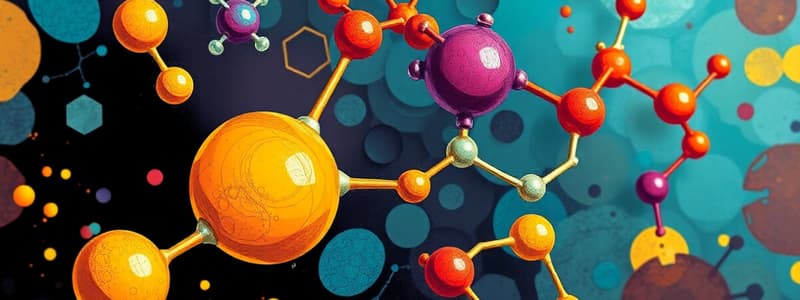Podcast
Questions and Answers
What color change indicates a positive test for starch when iodine solution is added?
What color change indicates a positive test for starch when iodine solution is added?
- Orange-brown to blue-black (correct)
- Clear to red
- Yellow to green
- Blue to teal
Which of the following correctly describes a positive test for protein using Biuret solution?
Which of the following correctly describes a positive test for protein using Biuret solution?
- Change from blue to violet/purple (correct)
- Change from brown to blue
- Change from red to green
- Change from yellow to clear
In a test for lipids, what is observed to confirm a positive result?
In a test for lipids, what is observed to confirm a positive result?
- Formation of a cloudy emulsion (correct)
- Outgrowth of particles
- Change of color to pink
- Formation of a clear solution
Which bases pair correctly in DNA structure?
Which bases pair correctly in DNA structure?
What structure forms the 'backbone' of a DNA molecule?
What structure forms the 'backbone' of a DNA molecule?
What are the primary chemical elements found in carbohydrates?
What are the primary chemical elements found in carbohydrates?
What is a disaccharide formed from two glucose molecules?
What is a disaccharide formed from two glucose molecules?
Which type of lipid is typically solid at room temperature?
Which type of lipid is typically solid at room temperature?
What are proteins primarily composed of?
What are proteins primarily composed of?
What is the role of Benedict's solution in food testing?
What is the role of Benedict's solution in food testing?
What color change indicates a positive test for glucose using Benedict's solution?
What color change indicates a positive test for glucose using Benedict's solution?
How many different amino acids are commonly found in proteins?
How many different amino acids are commonly found in proteins?
Which molecule serves as the basic unit of triglycerides?
Which molecule serves as the basic unit of triglycerides?
Flashcards
Carbohydrates
Carbohydrates
Organic molecules containing carbon, hydrogen, and oxygen. They are long chains of simple sugars.
Glucose
Glucose
A simple sugar, the basic building block of carbohydrates.
Maltose
Maltose
A type of carbohydrate formed when two glucose molecules join together.
Polysaccharides
Polysaccharides
Signup and view all the flashcards
Proteins
Proteins
Signup and view all the flashcards
Fats (Lipids)
Fats (Lipids)
Signup and view all the flashcards
Glycerol
Glycerol
Signup and view all the flashcards
Benedict's Test
Benedict's Test
Signup and view all the flashcards
Iodine Test
Iodine Test
Signup and view all the flashcards
Biuret Test
Biuret Test
Signup and view all the flashcards
Ethanol Test for Lipids
Ethanol Test for Lipids
Signup and view all the flashcards
DCPIP Test for Vitamin C
DCPIP Test for Vitamin C
Signup and view all the flashcards
DNA
DNA
Signup and view all the flashcards
Study Notes
Biological Molecules
- Biological molecules—carbohydrates, proteins, and lipids—are the building blocks of life.
- They all contain carbon, making them organic molecules.
Chemical Elements
- Carbohydrates: Contain carbon, oxygen, and hydrogen.
- Proteins: Contain carbon, oxygen, hydrogen, nitrogen, and sometimes sulfur.
- Lipids: Contain carbon, oxygen, and hydrogen.
Carbohydrates: Large Molecules from Smaller
- Carbohydrates are long chains of simple sugars.
- Glucose is a simple sugar (monosaccharide).
- Two glucose molecules form maltose (disaccharide).
- Many glucose molecules form starch, glycogen, or cellulose (polysaccharides).
Fats (Lipids)
- Most fats in the body are triglycerides.
- Triglycerides are composed of one glycerol molecule and three fatty acid chains.
- Fatty acids vary in size and structure.
- Lipids are categorized as solids (fats) or liquids (oils) at room temperature.
Proteins
- Proteins are long chains of amino acids.
- There are about 20 different amino acids.
- Amino acids have a similar basic structure but differ in their "R" group.
- Amino acids link to form proteins.
- The order of amino acids determines the protein's function.
- A small change in amino acid order results in a different protein.
Food Tests
- Glucose (reducing sugars): Benedict's solution, heated to 60-70°C, changes color from blue to orange/brick red if glucose is present.
- Starch: Iodine solution changes color from orange-brown to blue-black in the presence of starch.
- Proteins: Biuret solution changes color from blue to violet/purple in the presence of protein.
- Lipids: A food sample mixed with ethanol, then water, forms a cloudy emulsion if lipids are present.
- Vitamin C: DCPIP solution loses its blue color in the presence of Vitamin C.
Studying That Suits You
Use AI to generate personalized quizzes and flashcards to suit your learning preferences.




